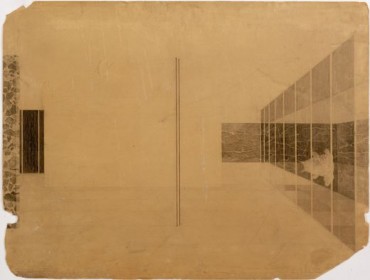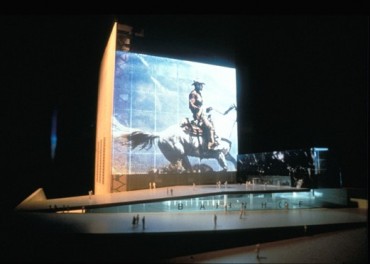
1/ Jones and Laughlin Steel Company, Pittsburgh, May 1942

2/ Mies Van der Rohe, German Pavillon, Barcelona, 1929

3/ Louis Kahn, National Assembly, Dacca, Bangladesh, 1962- 1974

4/ Le Corbusier, Notre-Dame-du-Haut, Ronchamp, 1950-55 Source: Elias Torres, Zenital Light (Barcelona: Actar, 2006

5/ Anthony, McCall, Long Film for Four Projectors, 1974 Photograph: Henry Graber, 2003

6/ OMA, Centre for Art and Media Technology, Karlsruhe, 1992

7/ James Clerk Maxwell, Maxwell’s demon, 1871
16.7.2014 – Issue 15 - Fire – Allen Stan , von Mackensen Till, Concheiro Isabel – Interviews, Videos
Fire and Light
Interview with Stan Allen
IC Fire as a form of energy and its mastering gave rise to human civilization.
From its central role in the organization of space, the architectural
presence of fire has declined somewhat during the last two centuries.
On the one hand, its potential dangers led it to be shut away, first in
stoves and later in the anonymity of our basements, and on the other,
the appraisal of modernism led to a more homogenous architecture
with thermally uniform spaces. How would you describe the relationship
between fire and architecture? How has this relationship changed
with the increased implementation of technology?
SA You describe quite accurately that one of the effects of modernism has
been to detach ourselves from our relationship with the natural elements,
and fire in particular. I would say there are two things about the way in which
fire is present in architecture. First of all, what we have done in architecture
is to compartmentalize fire. We have domesticated it, in a way, first with the
hearth and now with mechanical systems of heating and cooling. Fire is very
much hidden from view in buildings and, when it is present, it is decorative.
But then there is another aspect, which is this very old, deep relationship with
fire as an agent of transformation. Fire is what gave us brick and terracotta;
fire is what gave us alchemy and the ability to transform materials. Architecture
is deeply implicated in this process of bringing physical construction
into the world, which is partly mechanical, but also transformative.
In terms of technology, the big transformation took place in the nineteenth
century with the introduction of large-scale steel production. That is
what moved architecture from the creation mode of heavy vaulting and masonry
stacking to the possibility of creating a lightweight architecture. This
was only possible by means of the massively energy-intensive process of
transforming the elements into usable steel. This is also the paradox of modernity;
it is these new industrial processes that enabled social, spatial and
technological transformations, but they also detached us from direct connection
to those materials, because they were operating at the large scale of
industrial production. One could say that architects like Mies van der Rohe,
who was so attentive to the quality of a steel section, connected back to
steel very indirectly. I don’t think we can ever recuperate a direct connection,
since Pandora’s box is now open, and we cannot close it again. I think we
have to find ways of connecting back to these conditions that are not simply
decorative and conformal, but that really speak about our larger condition of
being in the natural world. In this respect, it is necessary to understand them
as embedded energy. One of the main challenges of the twenty-first century
is to find ways to understand the material transformations of the industrial
revolution as being continuous in some way with the conceptual transformations
of the information revolution of the last century. Part of the reason for
my interest in ecology comes not so much from environmentalism and green
technology as from the notion of ecology as a model of a dynamic, adaptive
systems. If we start thinking about industrial production and the larger ecologies
of the world in continuity with the notion of information exchange and
adaptability, we begin to have a more fluid relationship with technology than,
for example, the hard qualities of nineteenth-century industrial production.
IC Light can be used as a metaphor in music, be brought onto a canvas
with shining luminescence or be expressed by a thousand different
words. However, none of these art forms can do what architecture
does—namely, deal with light as a substance. What is your reaction to
that?
SA Without light, there is no definition of form. Light itself has many forms,
perhaps more than fire, and it is the infinite malleability of light that is so
extraordinary. To use Mies again as an example, I always find it interesting
to see that his drawings are very dry, disembodied and immaterial. He
understood very well that the architectural drawing functions like a notational
device. The architect has the intelligence to know that a certain form, drawn
in a certain way, will behave in a certain way in light. The simulation of light,
especially now with rendering software, is a very poor imitation of reality.
Elemental conditions can never be captured in a drawing; they can only be
notated, and abstraction in the form of notation is faith in the reality that lies
beyond the drawing. When I started studying, I had a drawing teacher. We
would be drawing figures in black and white, and he would talk about colour
in those black and white drawings. The notion that light is colour, that light
makes colour visible, has stayed with me.
IC From the Revolutionary Architects to Le Corbusier (“the sun, my
master”) and Kahn (“Silence and Light”), light has been regarded as a
constructive correlate that gives inner spaces their specific character
and adds plasticity to the outer volumes. In what ways is light a kind of
amplifier of architectural sensations?
SA Kahn is, in a way, the elemental architect. He very much saw his buildings
as existing in a timeless condition. An important aspect of his work is
the sense of spatial layering, “wrapping ruins around buildings”, letting the
direct and indirect light fall on several different surfaces as it moves through
the building’s envelope. In one of his famous statements, he clarified that “it
is the single ray of light that shows the actual darkness”. However, light was
for him not an end in itself; it was part of the notion of creating larger spaces
for people to gather. Regarding Le Corbusier, the most important element
to consider is the relationship to the body. Le Corbusier’s architecture has
to be perceived in motion, whereas Kahn’s architecture is more static in its
creation of centralized spaces and the choreography of the route leading
to that place. With Le Corbusier, it is more about the directed path of the
viewer. That is what activates the relationship between light and architecture,
because you have to walk around those curved volumes to see the light
changing as you move. I think Le Corbusier’s use of light, more than that of
Mies or Kahn, was influenced by the cinema, by the sense of the dynamic
condition of light, of the projection of 24 frames per second that creates the
illusion of movement. Today, we have to deal with a very different condition
of light, which is the binary coding of pixels on the video screen. The screen
emanates light, whereas the mechanical projection of the cinema projects
light onto a surface. We can talk about atmosphere in relationship to light in
cinema in ways that we cannot in relation to videos. If we think for example of
the work of British artist Anthony McCall, he made visible the atmosphere of
a room through light projections. I think the flat condition of the screen is the
light condition we are dealing with in the twenty-first century. I would say that
the use of light in the sense of creating an atmosphere in contemporary architectures
like that of SANAA is more deeply connected to the sense of embedded
light that is associated with the condition of the screen as opposed
to the projected light in the work of Le Corbusier and Kahn. If we consider the
Baroque and all the devices to catch light and the articulation of surfaces to
bring light into architecture, there is a knowledge that we, as architects, have
lost to some extent today. This knowledge was bound up with the enlightened
notion of light as revealing, illuminating. The techniques of the Baroque
were able to combine a scientific and perceptive notion of light in an almost
seamless way. I think we have a different relationship to light today, and we
are still beginners with the tools we have at our disposal to reconnect the
scientific with the perceptual.
IC The relationship between architecture and energy associated with fire
has historically been achieved through passive and active strategies:
in Reyner Banham’s terms, the structural environment that regulates
free energy and light through construction and matter, and the poweroperated
environment that is based on the exploitation of cumulated
energy and regulated heat from combustibles. How would you describe
the relationship between passive and active elements?
SA I think there is a split between the celebration of artificiality and the
refusal of modern technology that seeks something more traditional and
elemental in architecture. To me, these are conceptually two sides of the
same coin. They both insist on the natural and the artificial. There is no such
thing as nature in its untouched form, since it has always been manipulated
and transformed by human presence. It is really more about articulating the
complexity of this relationship than coming down on either side. We create
artificial environments both by intensifying the natural conditions, be they
light, air or the relationship with the ground, and by providing artificial light
and heat. In the urban context, these issues become more crucial. Cities
are the most intense concentration of artificial environments and, at the
same time, the most efficient way to use energy. This is the irony: the most
sustainable thing we can do is to live in the theoretically most unnatural way
possible. We were recently commissioned by the city of New York to look at
the housing stock and to propose adjustments to the city’s code in order to
reflect new social dynamics. Rather than thinking about constructing from
scratch, we looked at the existing stock of buildings and in particular at the
office buildings from the 1960s and 1970s. Apart from their lack of energy
efficiency, another problem was the fact that they are disconnected from
the city and create a programmatic monoculture. Our proposal was to take
the mixture of uses within a typical Manhattan block and flip them up, using
the existing structure as a scaffolding to create new systems of movement,
new ways of organizing the space to project some of the block’s dynamism
up into the vertical structure. I think the larger significance of this, apart from
the argument for reuse and respecting embedded energy in an existing city,
is that no structure is actually sustainable in the long run if it does not add to
the social dynamic and ecology of the city.
Excerpts from an Interview with Isabel Concheiro and Till von Mackensen
Download article as PDF

